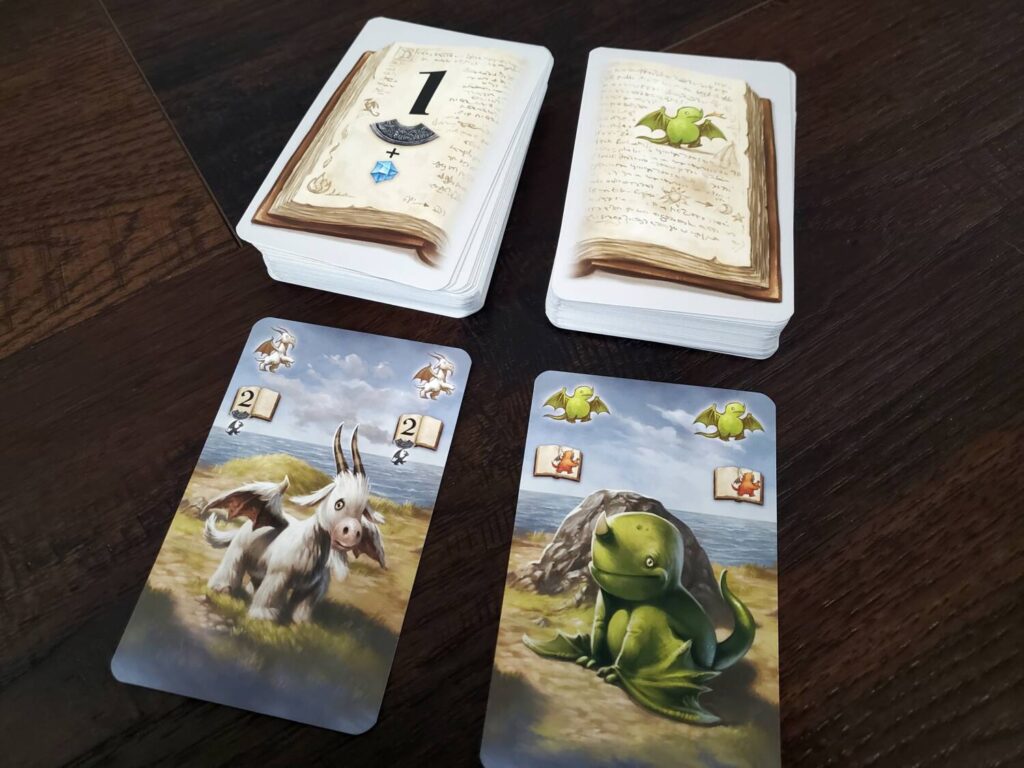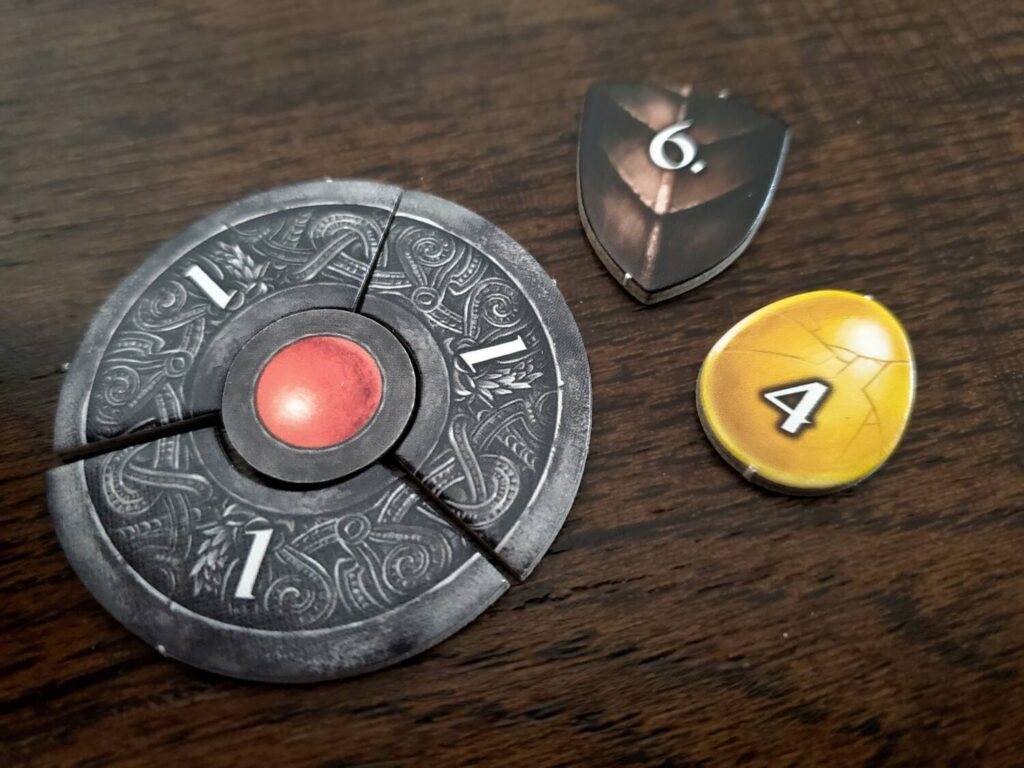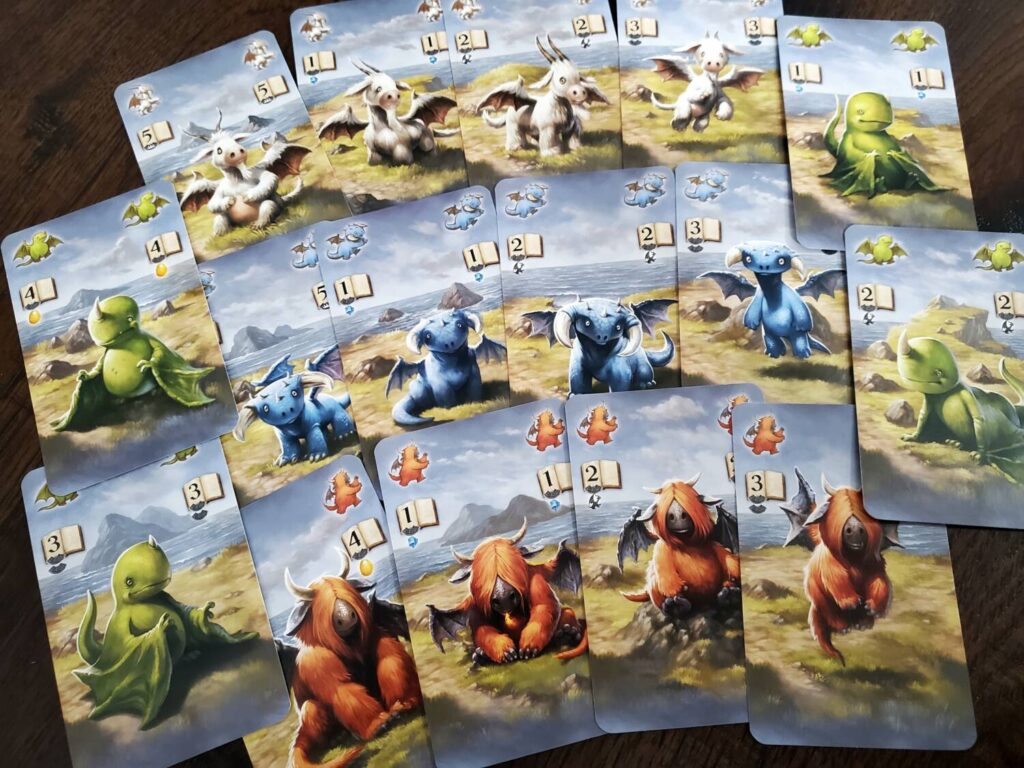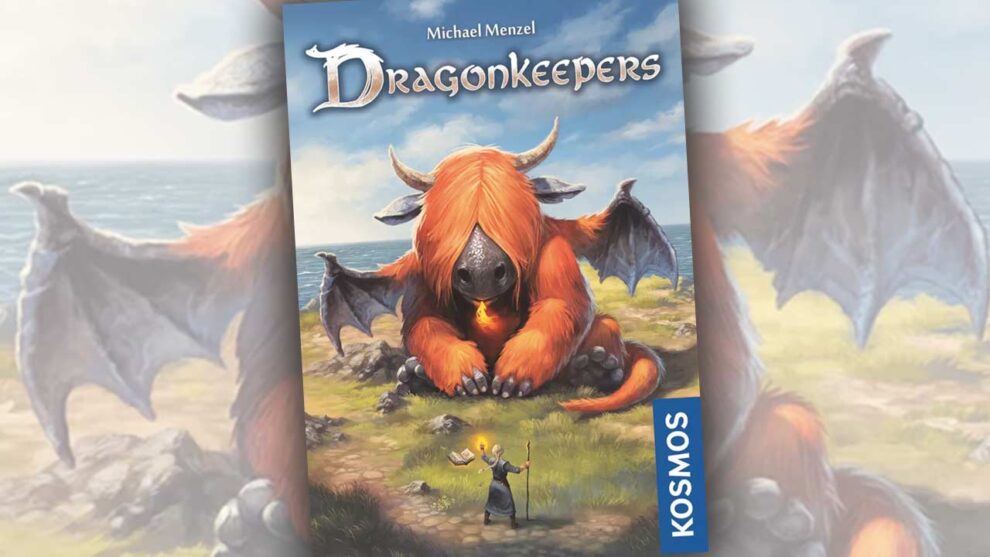Disclosure: Meeple Mountain received a free copy of this product in exchange for an honest, unbiased review. This review is not intended to be an endorsement.
If you’ve seen Michael Menzel’s name on a board game box, it’s probably as an artist. My first conscious introduction to his work was probably First Class: All Aboard the Orient Express, but he has worked on everything from Catan to the Exit series to recent hits like Wandering Towes. His paints are everywhere; but his design credits boast a couple solid games as well, such as The Adventures of Robin Hood and his family adventure, The Legends of Andor.
Dragonkeepers is his latest design, also published in cooperation with Thames & Kosmos. Players take up the role of—you guessed it—dragonkeepers, corralling the mythical beasts by color in exchange for amulets and golden eggs. Okay, the game narrative isn’t exactly compelling, but the artwork is charming and the gameplay is surprisingly interesting.
A bit of push-your-hand-management
The core mechanism is quite fascinating. Two decks form the left and right pages of a book. The card backs on the left page deck indicate a number and a reward. The right side indicates a color. One card from each deck always sits nearby with its face-up dragon side visible. Players draft one, two, or three cards from the face-up choices, replenishing each time.

With each drawn card, the combination on the face-down pages changes. One-blue becomes one-red, then three-red, then three-green. After drawing cards, the active player can then lay the visible combination in front of them into that color’s pile, collecting the reward.
Lending a bit of control to the luck-pushing, the active player can place cards back onto the face-down page decks to alter the play requirement before laying cards down. Once they’ve completed their turn, each other player then has the chance to lay the required combination for the same reward. In this way every player is active on every turn.
Players can have as many as four piles in front of them, one for each color. Here’s the wrinkle: when a color becomes sandwiched between two others, that color is then off-limits for the player for the remainder of the game. Choosing when and how to limit options is one of the key tensions in the game.
The primary reward for laying cards is amulet pieces. Three pieces form a complete amulet, allowing the player to select a face-down pearl for the center. Amulet pieces are released with increasing value throughout the game, making late gains particularly valuable; but the pearls work in the opposite direction, with the most lucrative going to the first completed amulets. Playing sets of five or six cards allow for drawing the most valuable amulet pieces in play. Golden eggs are less common and the player with the most gets a nice bonus. As players collect their fourth dragon color, there are additional bonuses waiting for pushing limitations to the limits.

The final two rewards impact gameplay. Blue gems purchase a fourth card during the draw, plus they serve as the payment for a corporate special ability revealed at the beginning of the game. Shadow dragon cards are wilds when laying cards and also boast a six on the back, the largest set possibility in the game.
The game runs until a number of amulets are completed depending on the player count, at which point players flip tokens, do a bit of math, and celebrate someone’s victory.
I never saw the dragons coming, I swear
Forgive my saying so, but when I see generic fantasy themes, I don’t always expect good things. In the interest of full disclosure, I didn’t have high hopes for Dragonkeepers. Goodness, I was wrong. I’m not ready to call it the game of the year or anything, but Dragonkeepers has absolutely over-delivered.
The card mechanism is wholly engaging. There is a palpable tension between flying toward the finish by taking every opportunity to drop even one card and patiently waiting to lay a five or six card set. There is an equal tension in knowing that everyone else is weighing the same decision. When neighbors are sitting on sizable hands of cards and you’re not, you just want to finish the last amulet because the game ends like a guillotine. As soon as that last pearl drops, it’s over, and it’s best if they never get the chance to capitalize.

And let’s not forget that on every turn, every player will have the opportunity to respond to the combination on the pages. As the amulets add up around the table, everyone is doing the math to determine the likelihood of their next turn. I’ve finished games with five-of-a-kind in my hand while the player immediately before me ends the game. It hurts, and it makes me want to play again.
In the early game, amulet pieces are worth one point. Earning the right to the better bits that come by larger sets might net twenty points. One way is cheap and easy, the other is slow and methodical. Both have their merits. I really do enjoy that these dragons create choices. Sometimes when you’re in the middle of saving for a huge payload the next level of amulet piece opens up and you realize it’s better to drop the three you have because you’ll net critical points in a hurry and push the game towards its end. From moment to moment, the landscape shifts, and with it your preferences.
The special abilities are interesting and game-changing. All of a sudden the blue gems might become supremely important for their capacity to bend the rules and escape an awkward or otherwise impossible situation. Ignoring the sandwich rule, pulling played dragons back into your hand, being able to defy the book’s requirements for laying cards. These are massive twists along the way.

And the best part? Dragonkeepers has an honest box. Twenty minutes means twenty minutes. Once players understand the rhythms and the possibilities with collecting and returning cards, turns really sing. The game grabs your attention and it really doesn’t let go because it’s always possible you’ll get to capitalize on someone else’s good (or bad) decision.
My kiddos love the dragons. My six-year-old can play, even if she can’t dominate. My ten-year-old can win. A table full of adults can cast eagle eyes all over the table and try to create their moments, deny their opponents, and weasel in for the right amulet at the right moment. I really do think there’s more to this box than meets the eye.
In case you’re wondering, the card design is smart. The cards have icons (for both right and left splayed hands) indicating what is on the back so you don’t have to sit there looking at both sides. They are oversized, which still allows for the art to dominate the field of vision without losing readability. The cardboard bits are cardboard—they work.
The setup is very hands-on. Someone needs to pull out a number of amulet pieces and then organize them by number. Someone needs to shuffle the two decks. Someone needs to flip the pearls face down and separate them, and someone needs to get all the bits easily visible. But honestly, it only takes a couple minutes.
Dragonkeepers is worth a play for its mechanics. If the theme speaks to you, it’s all the more inviting.












Add Comment